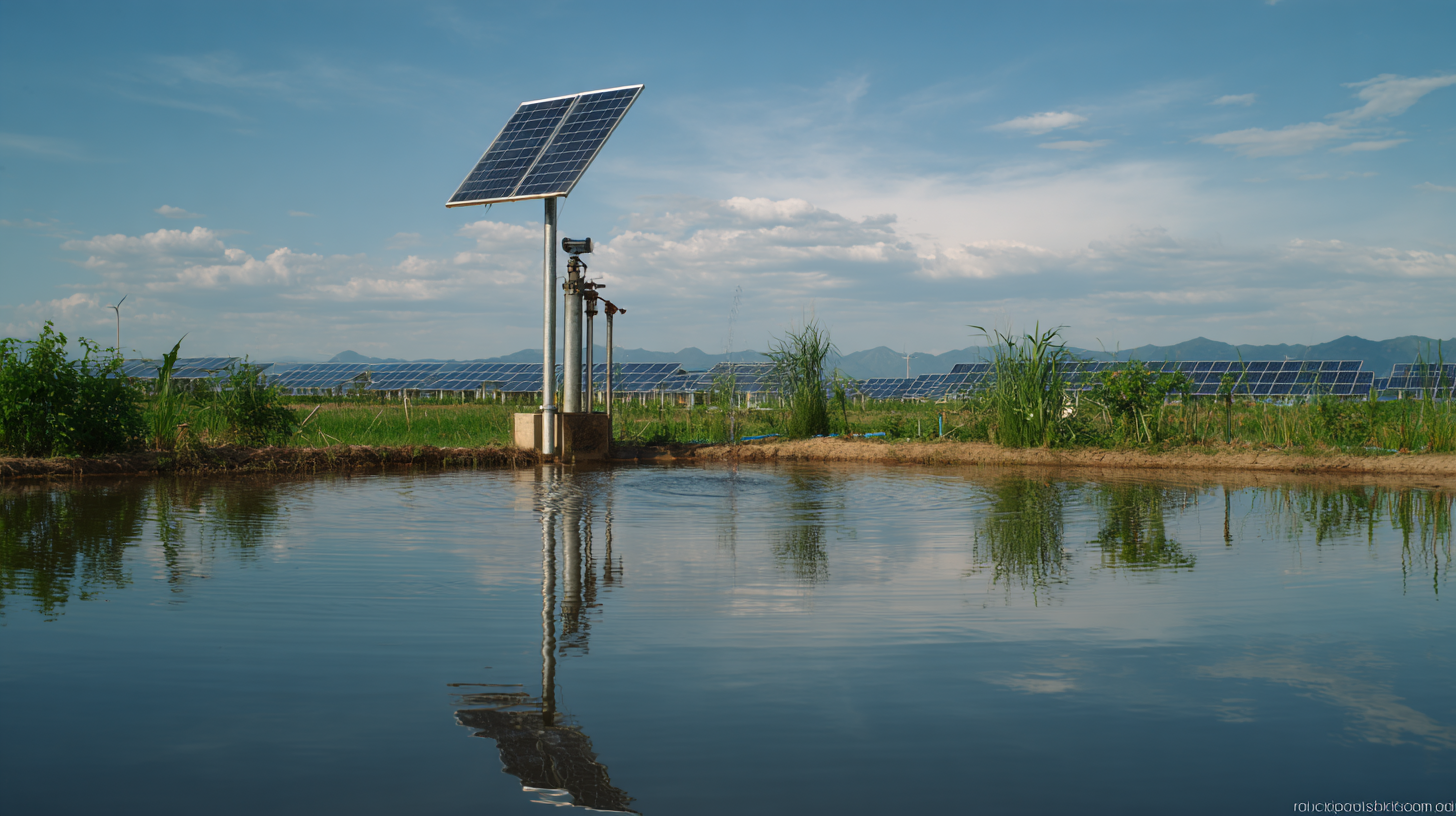Exploring Real Life Applications of Best Solar Pumps in Agriculture and Industry
In recent years, the agricultural and industrial sectors have increasingly turned to innovative technologies to enhance efficiency and sustainability, with Solar Pumps emerging at the forefront of this transition. As per the International Renewable Energy Agency (IRENA), the use of solar-powered water pumps can reduce energy costs by up to 80% compared to conventional diesel pumps. This shift not only promotes energy independence but also addresses the pressing issue of water scarcity, with irrigation accounting for approximately 70% of global freshwater usage. Furthermore, a report from Allied Market Research indicates that the solar pump market is projected to reach $3.4 billion by 2027, driven by the growing need for efficient water management solutions in agriculture and industrial applications. By exploring the real-life applications of Solar Pumps, we can better understand their role in enhancing productivity, reducing operational costs, and fostering sustainable practices across various industries.

Understanding Solar Pump Technology and Its Benefits for Agriculture
Solar pump technology is transforming the landscape of agriculture by offering a sustainable and efficient alternative to traditional irrigation systems. According to a report by ResearchAndMarkets, the global solar pump market is projected to reach USD 2.9 billion by 2027, highlighting the increasing adoption of solar-powered solutions in the sector. These pumps not only utilize renewable energy but also provide cost-effective solutions for farmers, significantly reducing operational costs associated with fuel and electricity.
One of the key advantages of solar pumps is their ability to operate in remote areas where electricity access is limited. This feature is particularly beneficial for developing regions, as it allows farmers to irrigate their crops reliably. A study conducted by the World Bank indicates that countries implementing solar water pumps have seen increases in crop yield by up to 50%, thereby enhancing food security.
Tips: When considering solar pump systems, it is essential to assess your water needs and sunlight availability to select the right pump size and type. Additionally, investing in high-quality solar panels can maximize efficiency and ensure longevity, providing a reliable source of water for years to come. Consulting with experts can also help in understanding local regulations and potential financial incentives for solar energy adoption in agriculture.
Key Types of Solar Pumps Used in Modern Farming Practices
 In modern farming practices, solar pumps are becoming increasingly essential, enabling farmers to harness renewable energy for irrigation. The key types of solar pumps used today include surface pumps, submersible pumps, and hybrid systems, each tailored to meet specific agricultural needs. Surface pumps are typically employed for shallow water sources, effectively drawing water for drip or sprinkler irrigation. Submersible pumps, on the other hand, are ideal for deeper wells, providing reliable water supply even from significant depths. Hybrid systems combine solar with traditional energy sources, offering versatility in areas with fluctuating sunlight.
In modern farming practices, solar pumps are becoming increasingly essential, enabling farmers to harness renewable energy for irrigation. The key types of solar pumps used today include surface pumps, submersible pumps, and hybrid systems, each tailored to meet specific agricultural needs. Surface pumps are typically employed for shallow water sources, effectively drawing water for drip or sprinkler irrigation. Submersible pumps, on the other hand, are ideal for deeper wells, providing reliable water supply even from significant depths. Hybrid systems combine solar with traditional energy sources, offering versatility in areas with fluctuating sunlight.
The adoption of solar-powered irrigation is transforming agricultural practices, particularly among horticultural farmers in regions like Kadiogo Province. This shift not only enhances water access but also contributes to increased food production while reducing carbon footprints. Furthermore, studies indicate a positive correlation between the use of solar energy in agriculture and improved farmer incomes, showcasing the economic advantages of this sustainable technology. As the market for solar water pumps continues to grow, driven by both environmental considerations and economic incentives, we can expect an expansive integration of these systems into everyday farming operations.
Real Life Case Studies: Successful Solar Pump Implementations in Agriculture
In the quest for sustainable agricultural practices, solar pumps have emerged as a game-changer. According to a report by the International Renewable Energy Agency (IRENA), adopting solar-powered irrigation systems can reduce energy costs by up to 80%, making it feasible for farmers to access water resources efficiently. Real-life case studies highlight the effectiveness of solar pumps in various agricultural settings. For instance, in India, a project in Rajasthan equipped over 1,000 farmers with solar pumps, resulting in a 50% increase in crop yields, enabling them to irrigate larger areas without the burden of electricity expenses.

Implementing solar pumps in agriculture comes with several advantages. To maximize their efficiency, farmers should consider the geographical layout of their land and crop water requirements. Additionally, integrating smart technology, like moisture sensors, can optimize irrigation schedules and conserve water, leading to more sustainable farming practices.
Moreover, it is essential to choose the right size and type of solar pump for your specific needs. Conducting a thorough site assessment and consulting with professionals can help ensure that the solar system installed is both reliable and cost-effective. As solar technology continues to advance, the potential for increased agricultural productivity and reduced environmental impact is significant.
Solar Pumps in Industrial Applications: Enhancing Efficiency and Sustainability
In the realm of industrial applications, solar pumps represent a significant leap towards enhancing both efficiency and sustainability. With the global market for submersible solar pumps projected to reach $1.5 billion by 2030, achieving a compound annual growth rate (CAGR) of 8.4%, industries are increasingly recognizing the value of integrating solar energy into their operations. As sector-specific needs evolve, technologies such as solar PV-powered refrigeration are also emerging, demonstrating improved energy efficiency and reduced power consumption. This aligns with the growing emphasis on operational optimization across industries, where sustainability is becoming a critical metric for success.
Moreover, the integration of renewable energy sources and advancements in electrolysis technologies are reshaping how industries can leverage solar pumps. By utilizing these pumps in combination with strategies for green hydrogen production, facilities can enhance their energy profiles significantly. As highlighted in recent reports, enhanced thermal performance can be achieved through technologies like nanofluids, which also contribute to environmental sustainability. This strategic focus on innovation and resiliency is essential as industries work to scale decarbonization technologies and adapt to the pressing demands of the energy transition.
Cost Analysis: Evaluating the Economic Viability of Solar Pump Systems
The economic viability of solar pump systems in agriculture and industry is increasingly recognized as a pivotal factor in achieving sustainable development goals. Recent studies highlight the significant cost advantages of implementing solar-powered irrigation systems, particularly for smallholder farmers facing traditional farming challenges. By harnessing solar energy, these systems reduce reliance on fossil fuels and lower operating costs, leading to enhanced productivity and profitability for farmers. The integration of photovoltaic pumping systems provides a dependable water supply for irrigation, significantly improving resource management in arid regions.
Moreover, a techno-enviro-economic analysis of grid-connected solar-powered floating PV water pumping systems illustrates substantial long-term benefits. These systems not only decrease carbon emissions but also optimize energy production through innovative design. Economic assessments reveal that initial investments in solar technology can yield favorable returns over time, particularly when combined with smart water management practices. As the agricultural sector seeks to transition towards more sustainable practices, evaluating the economic implications of solar pump systems will be crucial for fostering resilient farming communities and promoting broader adoption of renewable energy solutions.
| Application Area | Solar Pump Type | Installation Cost (USD) | Annual Operating Cost (USD) | Estimated Lifespan (Years) | Annual Savings (USD) | Payback Period (Years) |
|---|---|---|---|---|---|---|
| Irrigation in Agriculture | Submersible Solar Pump | $3,000 | $200 | 15 | $800 | 2.75 |
| Livestock Watering | Surface Solar Pump | $2,500 | $150 | 10 | $600 | 3.17 |
| Industrial Cooling Systems | Solar-Driven Chiller | $10,000 | $1,000 | 20 | $2,500 | 4.0 |
| Water Supply in Remote Areas | DC Solar Pump | $4,000 | $250 | 12 | $900 | 4.44 |
| Drip Irrigation Systems | Solar Utility Pump | $5,000 | $300 | 18 | $1,200 | 4.17 |
Contact Details
Address:
Solar Pump Solutions,
Borrisokane, Co. Tipperary, Ireland.
